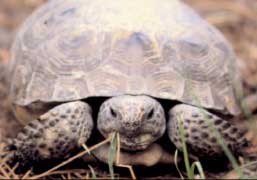|
 Bullfrog Creek Mitigation Park is one of eight upland preserves managed by FWC to protect gopher tortoises and other threatened or endangered wildlife species. Hillsborough County purchased the former cattle-grazing tract from the Sumner family in 1998 through its Environmental Lands Acquisition and Protection Program for $2.4 million. FWC reimbursed the county for the purchase in just three years as mitigation credits were sold to developers compensating for impacts to wildlife habitats. The mitigation park "sold out" in 2001. Bullfrog Creek Mitigation Park is one of eight upland preserves managed by FWC to protect gopher tortoises and other threatened or endangered wildlife species. Hillsborough County purchased the former cattle-grazing tract from the Sumner family in 1998 through its Environmental Lands Acquisition and Protection Program for $2.4 million. FWC reimbursed the county for the purchase in just three years as mitigation credits were sold to developers compensating for impacts to wildlife habitats. The mitigation park "sold out" in 2001.
The park consists of scrub habitat, long-leaf pine flatwoods surrounded by saw palmetto, wire grass and numerous native wildflowers and grasses. Oak trees and wax myrtles dot the landscape, held at bay by periodic prescribed fires that top-kill vegetation to keep the land open for foraging.
A recent visit revealed a study in contrasts, with dense shrubs and knee-high grasses on one side of a dirt road bisecting the property and fresh green shoots of young saw palmetto on the other with a smattering of healthy oaks and plenty of free range for turtle-maneuvering. The latter was burned back in May to "knock back the oak cover," said Shane Belson, a biological scientist with FWC.
Prescribed burns not only stimulate new growth and prevent overgrowth, they also are a hedge against uncontrolled wild fires. A lightning strike in 2001 sparked a wild fire at the park that closed a portion of I-75 for hours.
Entering Scrub Country
Largely restricted to this state, "scrub" is the respected elder among Florida's plant communities. The habitat is home to hearty and ancient life forms that have withstood the millennia. As sea levels rose, plants and animals were cut off from mainland populations, creating scrubby, desert-like hilltops on a narrow peninsula that would become known as the "Land of Flowers" or Florida.
Scrub is characterized by dense or patchy expanses of woody shrubs with little or no grass cover. In between the shrubs are patches of white sand. The high, dry and well-drained habitat are favored by the gopher tortoise, scrub jay, bobcat and Florida's largest array of endemic (found only in a particular region) plant species.
Altogether, over 20 species of animals inhabiting scrub are listed as rare, endangered, threatened or species of special concern by federal or state agencies. Preserving them is a race against time. Over twothirds of Florida's scrub has been destroyed, leaving disconnected islands of unique plants and animals.
From Piecemeal To Parks
FWC's mitigation parks program got its start in the 1980s with reviews of large-scale developments known as Developments of Regional Impact, or DRIs, that netted the agency little more than frustration.
"We had an opportunity to comment on how these projects would impact wildlife, but we ended up with little to show for it," says Allen. "We'd get a little bit of habitat here and there, but all of it eventually was surrounded by development."
The process for everyone was long and arduous, according to Allen. Developers were required to complete a lengthy application indicating how they would address a whole roster of impacts, including impacts to natural resources. Agencies were invited to sit at the table and suggest ways to mitigate for those impacts on site.
"It became apparent to us that while we were setting aside green space within these developments, we were missing the mark on habitat protection," Allen adds. Out of frustration the agency ultimately conceived the idea of consolidating mitigation dollars from numerous projects to purchase and protect significant tracts of habitat that they could then manage.
"What we created was a program with biological value, ongoing management and funding that allows open access and use, and gives developers more options for resolving their wildlife impacts," adds Allen.
"There isn't a single program as sophisticated in the country," says Allen, who notes that most states simply defer to federal government requirements that direct developers to minimize impacts to wildlife on-site.
But development isn't the only the threat to the gopher tortoise. Localized populations of gopher tortoises are plagued by a life-threatening upper respiratory disease, an outbreak that may have occurred when captive tortoises were released into the wild. Researchers at the University of Florida have undertaken a three-year study at a half-dozen sites to learn more about the nature and extent of the disease.
In the parable of the tortoise and the hare, the slow and steady tortoise prevails against his fleet-footed foe who stops to rest and falls asleep. Here's hoping this master of the underworld ambles safely into the future.

| Some 500 gopher tortoises have carved out homes at Bullfrog Creek Mitigation Park, one of a few remaining open patches in fast-growing southwest Hillsborough County where residential communities seem to be cropping up at every crossroads. Gopher tortoises can live more than 40 years, but only reach reproductive maturity after 10 to 20 years. For every 100 eggs they lay, only one to three survive to adult breeding age. While adult gopher tortoises have few natural predators, eggs often succumb to predation, and some gopher tortoises are plagued by a life-threatening respiratory disease.
|
 |
Unlike other species whose residences may be difficult to discern on properties slated for development, "It's a no-brainer when (gopher tortoises) occupy a property," says Mike Allen of the Florida Fish and Wildlife Conservation Commission. "You can determine pretty quickly whether it's being occupied." That makes the keystone species, whose burrows support a myriad of wild animals, an excellent candidate for mitigation.
|
|